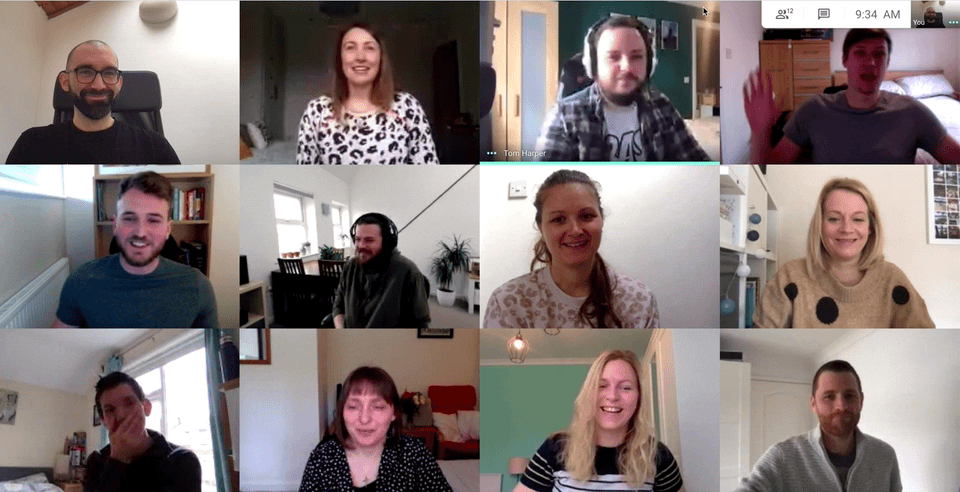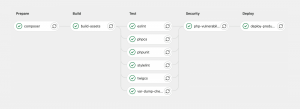The last year has been, to say the least, different! 12 months ago, inline with government guidelines, we shut our newly refurbed office doors and moved the whole team to full time remote working. Like many, it was a big shift for us and the experience has taught us a lot – logistically and emotionally. We wanted to reflect on how far we’ve come, the tough bits and the triumphs, what we’re excited to take forward and the things we can’t wait to get back to.
Digital tools
It’s difficult to understate the importance digital tools have had on everyone’s lives over the last 12 months. As a tech company we’ve always been big users of various online and SaaS based products. It wasn’t until we were forced to work from home that these truly came into their own, and we were forced to rely on them even more.
We’re long time users of Slack for internal communication, but this has always been text based chat and often backed up real world conversations. Slack quickly became the way we did everything, video calls, design reviews, pair programming etc. We found we had only really scratched the surface of what the tool could do for us. It also became the way we communicated with some clients and other external teams too. As our reliance on Slack grew, so did the notifications. Learning to tailor these to only what you needed enabled us to to regain some sense of sanity whilst still keeping track of all calls through the one platform.
As well as our reliance increasing on tools like Slack and Asana, we also noticed our clients were on a similar journey. Many projects focused on supporting a more distributed way of working; such as apps to enable Electronic ID Verification or provide remote technical support or a website to document and communicate brand guidelines to remote partners.
Wellbeing
Without being physically located with people, it’s so much harder to notice when people might be struggling. With many team members juggling home schooling and childcare it was definitely a more stressful period than normal. We found we had to be much more intentional with checking in on each other.
As well as regular all-hands morning calls and other structured check-ins, we’ve encouraged open video calls, where people can drop in during the day to chat socially with other team members. This helped capture some of the ‘water cooler’ moments from office life and kept individuals feeling more connected. We’ve also made an effort to meet up socially in small groups (when the rules have allowed), away from our computers. This has been especially good for the number of new hires we’ve made over the last year, who hadn’t met each other after months of working together.
There’s been a lot said about the bean-bag and pool table culture of tech companies, and whilst this stuff is often a gimmick and can feel quite forced, coming together in a physical space to socialise and have authentic fun definitely builds relationships which has positive impacts to individual wellbeing and team productivity. We don’t have bean-bags and we don’t have a pool table – we have historically played a lot of Mario Kart though, which as it turns out, is something that translates really well to working from home!
Sign up to get helpful articles, case studies and the latest news straight to your inbox.
Working with clients
We’ve been very fortunate that our clients have also adapted well to remote working. Getting to grips with; Zoom, Google Hangouts, Slack, Teams and the odd curveball service is a bit of a juggling act. But with a trusty cheat sheet for the various mute keyboard shortcuts for each platform in hand we’ve been able to keep in regular contact with clients. And like many have found, there are a ton of benefits to not always having to travel to meet in person.
Two specific areas have however taken some learning:
- Discovery sessions. Pre-lockdown, we’d get together in the studio with clients, make use of our massive whiteboard wall and co-design solutions to problems. This process was collaborative, engaging, yielded great results and was something we were very familiar with. As an integral part of our delivery process, this was something we couldn’t afford to lose when working remotely. Whilst it’s certainly not the same, with some iteration/practice we’ve been able to perfect an online discovery session using tools like Freehand from InVision. The infinite canvas really helps with space and the fact that everyone can participate at the same time is a huge plus. There’s also the added benefit of being able to keep the board exactly as you left it for a future meeting.
- Pitches and presentations. These are tough online! Logistically they’re difficult, especially if you have multiple people speaking from a single deck (no passing the clicker anymore!). Socially they’re also tough, speaking to a virtual room where everyone is on mute is very different from presenting to a quite physical audience. The lack of non-verbal feedback and hesitancy of people to interject mean we’re very much looking forward to getting back to doing these in person!
Automation
Working remotely brought all sorts of unexpected challenges to our delivery process that we just didn’t notice when we were in the office. An important part of our Quality Assurance process (QA) is peer-to-peer developer reviews. Prior to lockdown this would happen by two or more team members huddling around a computer and discussing, tweaking and approving in person. In a remote world we had to think differently, forcing us to review our entire QA process and instigate a more formal code review workflow.
In order to improve our process, we started to lean more heavily on some of the developer tools we were already using. This took us on a journey into the world of Continuous Integration with Gitlab. The more we dug, the more we found we could automate.
Over the course of the last year we’ve tailored automation pipelines for all of our client projects across mobile apps, web apps and websites, with some significant wins.
Our big wins have been:
- Deployment. We were already using automation friendly tools for deployment but we still required a team member with correct permissions to kick off the process from their machine. The pipelines enable us to remove this step and make it a defacto result of a successful code review. The additional benefit is a far greater visibility for Project Managers on each release.
- Mobile app builds. Building mobile apps for release can be fiddly as there are many moving parts to the development environment (including a Mac with specific software installed for iOS). By creating a robust pipeline we’ve enforced a more repeatable build process that can also be triggered by less technical team members.
- Automated testing. We’re big fans of test-driven development and have a defined code style that all developers must adhere to but these checks are only useful when they are run! By making these part of the pipeline for every code-review, we ensure that no regressions are introduced.
- Security. Checking all 3rd party packages against a vulnerability database before each deploy prevents us from publishing code with known security issues.
By looking at the jobs that were taking up the most time and automating them, we’ve been able to focus more time on useful, creative work for clients and reduce bottlenecks around certain individuals. The benefits are not only felt by ourselves but get passed onto our clients in increased productivity too:
- We spend less time battling with config and development environments
- The team can focus on their core responsibilities more, rather than having to also understand and own processes such as deployment
- No one person is now a critical blocker on any given project
- Everything is more repeatable
- Many issues are now caught automatically, before a human needs to be involved.
Wrapping up
Whilst the last year has been challenging, we’ve grown, learnt a lot, honed our processes and have sharpened our skills at being agile and adaptable. By being forced to think differently, we’ve thrived and whilst we’d rather it hadn’t taken the heartache of a global pandemic, we’re better for the shakeup. As things begin to open up, we’re excited to find our “new normal”. A way of working that enables the same freedom and flexibility that remote working has afforded us, but still encourages and values the social benefits of physically working together.
We certainly have no plans to close the office and become fully remote, but we also won’t be rushing back to full time office work.
If you’d like to know more about some of the changes we’ve made, want a copy of our mute cheat sheet or want to book a face to face coffee for the end of June, get in touch. We’d love to hear from you.





